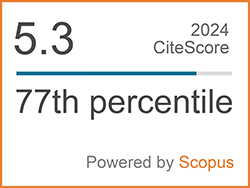Polydimethylsiloxane Based Flexible Antenna with Enhanced Performance and High-Efficiency for Biomedical Applications
Abstract
Keywords
[1] W. H. W. Hassan, N. Y. Li, A. M. Azize, Z. Zakaria, N. A. Shairi, and M. H. A. Hamid, “Simulation on wideband antenna based on Polydimethylsiloxane (PDMS) for medical imaging application,” Journal of Physics Conference Series, vol. 1502, no. 1, 2020, Art. no. 012008, doi: 10.1088/1742-6596/1502/1/012008.
[2] P. K. Sharma, N. Gupta, and P. I. Dankov, “Analysis of dielectric properties of polydimethylsiloxane (PDMS) as a flexible substrate for sensors and antenna applications,” IEEE Sensors Journal, vol. 21, no. 17, pp. 19492–19504, 2021, doi: 10.1109/JSEN.2021. 3089827.
[3] S. M. Abbas, S. C. Desai, K. P. Esselle, J. L. Volakis, and R. M. Hashmi, “Design and characterization of a flexible wideband antenna using polydimethylsiloxane composite substrate,” International Journal of Antennas and Propagation, vol. 2018, 2018, Art. no. 4095765, doi: 10.1155/2018/4095765.
[4] A. S. Giftsy, U. K. Kommuri, and R. P. Dwivedi, “Flexible and wearable antenna for biomedical application: progress and opportunity,” IEEE Access, vol. 12, pp. 90016–90040, 2023, doi: 10.1109/ACCESS.2023.3291025.
[5] N. Y. Li, Z. Zakaria, N. A. Shairi, H. Alsariera, and R. Alahnomi, “Design and investigation on wideband antenna based on polydimethylsiloxane (PDMS) for medical imaging application,” Przegląd Elektrotechniczny, 2020, doi: 10.15199/ 48.2020.03.21.
[6] S. Singh, R. Mishra, A. Kapoor, and S. Singh, “A comprehensive review and analysis of the design aspects, structure, and applications of flexible wearable antennas,” Telecom, vol. 6, no. 1, p. 3, 2025, doi: 10.3390/telecom6010003.
[7] M. Hasan and A. Islam, “Wideband compact flexible patch antenna design on polydimethylsiloxane (PDMS) for wearable technology,” Cureus Journal of Engineering, vol. 2, 2025, doi: 10.7759/s44388-025-04462-7.
[8] M. Hussain, W. A. Awan, S. M. Abbas, and Y. Zhu, “Design and development of low-profile polymer based broadband antenna for on-body applications,” Results in Engineering, vol. 25, 2025, Art. no 103818, doi: 10.1016/j.rineng. 2024.103818.
[9] A.K. Banale, K.A. Fante, and S.S Kumar, “Designs and materials of flexible wearable microstrip patch antennas: A systematic review,” Discover Applied Sciences, vol. 7, 2025, Art. no. 477, doi: 10.1007/s42452-025-06933-2.
[10] P. K. Sharma and J.-Y. Chung, “Evaluation of polydimethylsiloxane (PDMS) as a substrate for the realization of flexible/wearable antennas and sensors,” Micromachines, vol. 14, no. 4, p. 735, 2023, doi: 10.3390/mi14040735.
[11] S. J. Fusic, T. Sugumari, J. Giri, R. Sitharthan, A. S. Badawy, and N. Kachouri, “A compact smiley shaped flexible patch antenna for ISM band applications,” AIP Advances, vol. 14, no. 6, 2024, Art. no. 065332, doi: 10.1063/5.0192406.
[12] A. A. Bakar, F. Hasnan, A.R. Razali, A.F.A. Rahim, S. Othman, T. Ali and R. Radzali, “Polydimethylsiloxane as a potential antenna substrate,” Acta Physica Polonica, vol. 135, no. 5, pp. 938–941, 2019, doi: 10.12693/APhysPolA. 135.938.
[13] S. K. Agarwal, P. R. Shukla, and N. K. Verma, “Flexible PDMS-based antenna for body-centric wireless communication at 2.45 GHz,” IEEE Transactions on Microwave Theory and Techniques, vol. 66, no. 4, pp. 1689–1695, 2018, doi: 10.1109/TMTT.2018.2794980.
[14] M. Wang, Z. Liu, and J. Dong, “Liquid metal-embedded layered-PDMS antenna for flexible and conformal applications,” Frontiers in Physics, vol. 10, 2022, Art. no. 872992, doi: 10.3389/fphy.2022.872992.
[15] P. K. Sharma and N. Gupta, “Design and analysis of polydimethylsiloxane (PDMS) and Jean substrate based flexible antenna for ultra-wideband applications,” IEEE MTT-S International Microwave and RF Conference (IMARC), 2021, pp. 1–4, doi: 10.1109/ IMaRC49196.2021.9714626.
[16] H. A. Rahman and A. Rahim, “Dual band PDMS based flexible antenna for wearable application,” in IEEE MTT-S International Microwave Workshop Series on RF and Wireless Technologies for Biomedical and Healthcare Applications (IMWS-BIO), 2015, pp. 193–194, doi: 10.1109/IMWS-BIO.2015. 7303873.
[17] M. B. Fayed, A. R. Shaddad, and I. S. Othman, “Wearable PDMS-based flexible antenna for RFID applications operating at 2.45 GHz,” IEEE Access, vol. 7, pp. 9221–9227, 2019, doi: 10.1109/ACCESS.2019.2891280.
[18] M. Hussain, H. Zahra, M. Asadnia, S. M. Abbas, and Y. Zhu, “PDMS based dual band flexible antenna for ISM and WLAN portable applications,” in 4th URSI Atlantic and Asia Pacific Radio Science Meeting (AT-RASC 2024), 2024, doi: 10.46620/URSIATRASC24/ GFOA6496.
[19] C. P. Lin, C.-H. Chang, Y. T. Cheng, and C. F. Jou, “Development of a flexible SU-8/PDMS-based antenna,” IEEE Antennas and Wireless Propagation Letters, vol. 10, pp. 1108–1111, 2011, doi: 10.1109/LAWP.2011.2166971.
[20] A. Zandamela, N. Marchetti, and A. Narbudowicz, “Flexible multimode-based beamforming MIMO antenna,” in European Conference on Antennas and Propagation, EuCAP, 2023, pp. 1–5, doi: 10.23919/EuCAP 55385.2023.10111691.
[21] S. K. Patel, P. B. Chaturvedi, and A. Gupta, “Design of PDMS-based flexible antenna with low return loss and high efficiency for wearable applications,” IEEE Transactions on Antennas and Propagation, vol. 67, no. 6, pp. 3893–3897, 2019, doi: 10.1109/TAP.2019.2908397.
[22] A. Y. Ashyap, S. H. Dahlan, Z. Z. Abidin, H. A. Majid, F. C. Seman, X. Ngu, and N. A. Cholan, “Flexible antenna with HIS based on PDMS substrate for WBAN applications,” in IEEE International RF and Microwave Conference (RFM), 2018, pp. 69–72, doi: 10.1109/RFM. 2018.8711625.
[23] A. H. Zaidi, S. A. AlSaeed, and M. A. Khalid, “Low-cost flexible antenna for 2.45 GHz ISM band based on PDMS substrate,” IEEE Transactions on Antennas and Propagation, vol. 65, no. 9, pp. 4567–4573, 2017, doi: 10.1109/TAP.2017.2724560.
[24] J. Trajkovikj, J. -F. Zürcher and A. K. Skrivervik, “PDMS, a robust casing for flexible W-BAN antennas,” IEEE Antennas and Propagation Magazine, vol. 55, no. 5, pp. 287–297, 2013, doi: 10.1109/MAP.2013.6735538.
DOI: 10.14416/j.asep.2025.07.009
Refbacks
- There are currently no refbacks.
 Applied Science and Engineering Progress
Applied Science and Engineering Progress







